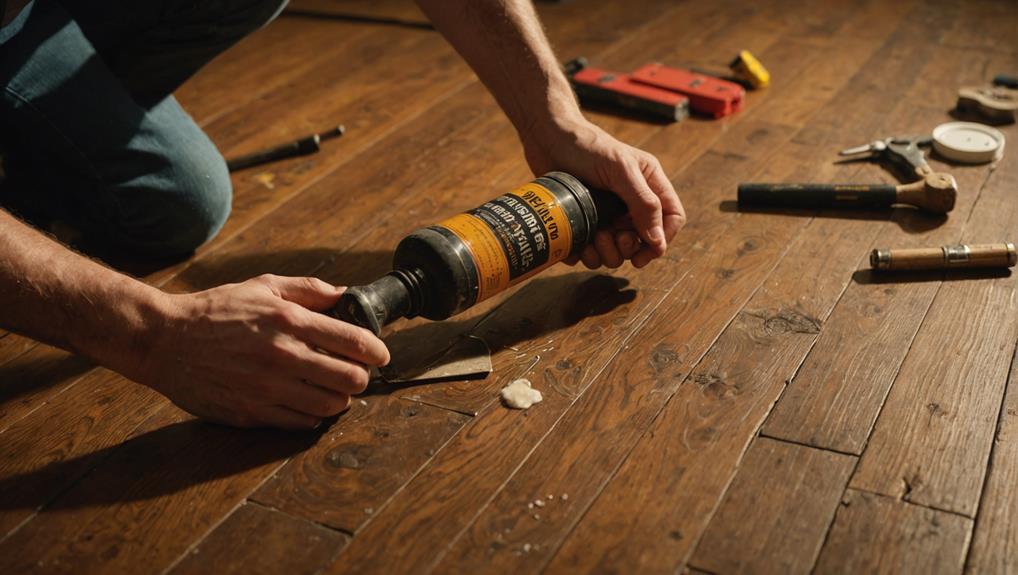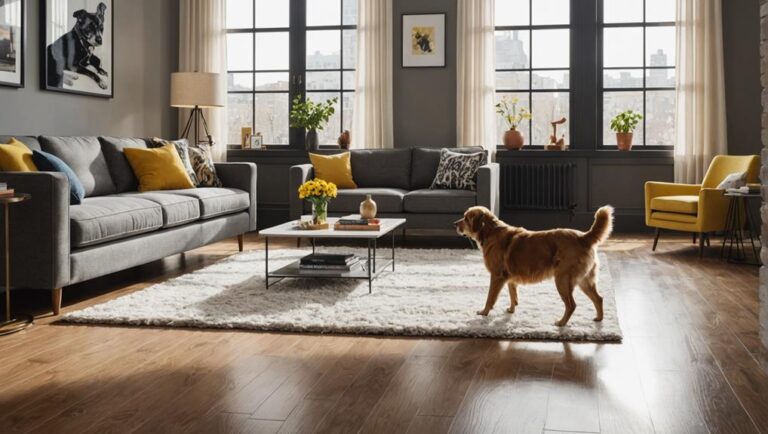To minimize floor creaking noises, start by pinpointing the creaking areas as you walk through your space. Once you identify the spots, tighten any loose floorboards using screws for a secure hold. You can also apply squeak-reducing lubricants like silicone spray in joints where boards meet. Consider adding carpets or rugs to dampen sound. Regular maintenance helps catch potential issues early. If creaking persists, you might explore floor replacement options. With these practical steps, you can create a quieter and more comfortable home environment. There's plenty more you can learn to tackle any stubborn noises effectively.
Identify the Source of Creaking
To tackle floor creaking effectively, you first need to pinpoint its source. Creaking causes can range from loose floorboards to inadequate sound insulation. Start by walking around your home, paying close attention to the areas where you hear the most noise. It's often helpful to do this at different times of day; temperature changes can affect how the materials expand and contract, amplifying the sounds.
Next, inspect the floorboards. Lift any rugs or carpets, and look for gaps between the boards. These gaps can lead to movement and subsequently, creaking. If you have a basement or crawl space, check the joists and beams. Look for any signs of shifting or damage, as these structural issues can lead to floor movement.
Don't overlook the potential for moisture-related problems, which can cause wood to warp and creak. High humidity can also affect sound insulation, allowing noises to travel more easily through the floor.
Once you've identified the source of the creaking, consider how you might improve sound insulation. Adding rugs or carpets can help absorb sound, while also providing a softer surface to walk on. Depending on the severity of the problem, you might need to consult a professional to address structural issues. By effectively identifying the source of your floor creaking, you create a safer and more comfortable living space.
Tighten Loose Floorboards
If you want to minimize floor creaking, start by identifying any loose floorboards in your home. Once you've found them, using proper fasteners and applying wood glue can help secure them in place. This simple process can greatly reduce those annoying sounds when you walk across the floor.
Identify Loose Floorboards
You might not realize it, but loose floorboards can greatly contribute to that annoying creaking sound in your home. Identifying these loose boards is essential for a quieter living environment. Start with a thorough floor inspection; walk around your space and listen for any unusual sounds. Pay particular attention to areas that seem to creak more than others.
Next, check the board alignment. Look closely at the seams between the boards. If you notice gaps or misalignment, it's a sign that the boards may not be securely fastened. You can also gently press down on each board with your foot; if you feel it flexing or moving, it's likely loose.
Use Proper Fasteners
Many homeowners underestimate the significance of using proper fasteners when tightening loose floorboards. Using the right fastener types not only secures the boards but also minimizes the risk of further damage. When selecting fasteners, take into account durability and compatibility with your flooring material.
Here are a few fastener types to think about:
- Screws: These provide strong, lasting hold and are less likely to pull out over time.
- Nails: While easier to install, they may not offer the same stability as screws.
- Wood Dowels: For a more permanent solution, dowels can be used in conjunction with glue.
Proper installation techniques are essential for effectiveness. Make sure that you drive the fasteners straight and at the correct angle, which helps prevent splitting the wood. Pre-drilling holes can also be beneficial, especially with screws, to avoid cracking. Finally, be sure to space the fasteners evenly along the floorboard to distribute weight and tension properly.
Apply Wood Glue
Applying wood glue can be an effective method to tighten loose floorboards and eliminate creaking. You'll want to choose the right wood glue types for the job, such as PVA (polyvinyl acetate) or polyurethane glue, as they provide strong adhesion.
Before you begin, make certain the area is clean and dry. Here's a quick reference table for application techniques:
| Wood Glue Type | Best For | Application Technique |
|---|---|---|
| PVA (White Wood Glue) | Indoor use | Apply evenly, clamp if needed |
| Polyurethane Glue | Moisture-prone areas | Use sparingly, spread thinly |
| Epoxy | High-stress joints | Mix thoroughly, let cure |
To apply the glue, lift the loose floorboard slightly and inject the glue into the gaps. Press the board back down and wipe away any excess glue. For added stability, consider using clamps while the glue sets. Always allow adequate curing time as indicated on the packaging to guarantee a secure bond. This simple process can greatly reduce floor noise and enhance the safety of your flooring.
Use Squeak-Reducing Products
If you're looking to reduce floor creaking, consider using squeak-relief lubricants and floor stabilizing solutions. These products can help eliminate noise and provide added support to your flooring. Applying them can be a simple and effective way to enjoy a quieter home.
Squeak-Relief Lubricants
Squeak-relief lubricants offer a practical solution for tackling floor creaking without extensive repairs. These products can help reduce those annoying sounds, making your home quieter and more comfortable. When evaluating your squeak relief options, it is crucial to choose the right lubricant types for your specific flooring material.
Here are some common lubricant types to take into account:
- WD-40: A versatile option that penetrates tight spaces and provides lasting lubrication.
- Graphite Powder: Ideal for wood floors, it won't attract dust and can effectively reduce friction.
- Silicone Spray: Great for both wood and synthetic materials, offering a water-resistant barrier.
Before applying any lubricant, verify the area is clean and dry, and follow the manufacturer's instructions for best results. Always test a small, inconspicuous area first to avoid any potential damage. By using the right squeak-relief lubricants, you'll not only minimize floor noises but also maintain the integrity of your flooring, guaranteeing a safer and more peaceful living environment.
Floor Stabilizing Solutions
After addressing some noise issues with lubricants, you might find that stabilizing your floors can further reduce creaking and enhance your home's overall comfort. One effective solution is to install additional screws or fasteners into your floor joists. This helps secure the floorboards tightly against the joists, minimizing movement and consequently, noise.
Another option is to use sound insulation materials. Adding insulation between your floor joists can absorb sound and dampen vibrations, making your home quieter. Choose high-density foam or fiberglass insulation, which not only reduces noise but also improves energy efficiency.
Consider using a product like anti-squeak adhesives or specialized floor underlayment, designed to provide extra cushioning and support. These products can effectively dampen sound waves and prevent further creaking.
Add Lubrication to Joints
One effective way to tackle floor creaking is by adding lubrication to the joints between the floorboards. If you've been dealing with squeaky floors, this method can provide a quick and effective fix. The creaking sound often occurs when the floorboards rub against each other or the nails that hold them in place. By applying some joint lubrication, you can greatly reduce or even eliminate these annoying noises.
Here's what you'll need to do:
- Select the Right Lubricant: Choose a lubricant that's safe for wood, such as silicone spray or graphite powder. Avoid oils that may damage the wood over time.
- Locate the Joints: Identify the areas where the floorboards meet and where the creaking is most prominent. You might need someone to walk on the floor while you listen for the squeaks.
- Apply Lubrication: Spray or sprinkle the lubricant into the joints. Make sure to work it into the gaps gently, allowing it to penetrate and coat the surfaces.
Once you've added the joint lubrication, walk across the area to check for any remaining squeaks. Taking this simple step can have a big impact on the overall comfort of your home. Not only will you enjoy quieter floors, but you'll also be taking proactive measures to maintain your flooring's integrity. Remember, a little lubrication goes a long way in preventing future issues!
Install Carpet or Rugs
If you've tried lubrication but still want to further reduce floor creaking, installing carpet or rugs can be an effective solution. Carpets and rugs not only provide a cozy aesthetic but also act as sound dampeners, minimizing the noise created by floor movement. By absorbing vibrations, they can considerably lessen the creaking sounds you might be experiencing.
When selecting carpet types, consider plush options that offer more cushioning and sound absorption. Berber or low-pile carpets can also work well, providing a balance between durability and comfort. If you're not ready to commit to wall-to-wall carpeting, area rugs can be an excellent alternative. They're versatile, easy to clean, and can be swapped out based on your decor preferences.
Rug placement matters, too. Strategically positioning rugs in high-traffic areas or where the creaking is most noticeable can help absorb the sound. Make sure to use rug pads underneath to prevent slipping and provide additional cushioning, which enhances noise reduction.
In addition to soundproofing, carpets and rugs can improve safety by providing a non-slip surface, reducing the risk of falls. For added effectiveness, make sure that your carpets or rugs are properly installed or placed to eliminate any potential tripping hazards.
Consider Floor Replacement
Could your floor creaking be a sign that it's time for a change? If you've tried other methods to reduce the noise and still find yourself hearing those annoying creaks, it might be time to think about replacing your flooring. While this can seem like an intimidating task, it can also provide a long-term solution to both noise and safety issues in your home.
Before diving in, reflect on these cost considerations:
- Budget: Determine how much you're willing to spend, as flooring options can vary greatly in price.
- Installation Costs: Factor in whether you'll do it yourself or hire a professional, as this can greatly influence your overall budget.
- Material Lifespan: Consider how long you want your new floor to last, as some materials may have a higher upfront cost but offer better durability.
When it comes to material options, you have plenty to choose from. Hardwood is a classic choice that can add value to your home, but it may be more expensive. Laminate is a budget-friendly alternative that mimics the look of wood without the high cost. Vinyl planks are another option, providing water resistance and comfort underfoot.
Ultimately, replacing your flooring can be a smart way to eliminate creaking noises while enhancing your home's safety and aesthetics. If you're committed to a long-lasting solution, investing in the right flooring can make all the difference.
Regular Maintenance Practices
After considering a flooring replacement, maintaining your new or existing floors is vital to prevent creaking and prolong their lifespan. Regular maintenance practices help guarantee your floors remain safe and comfortable. One of the best ways to achieve this is through preventive inspections. Take the time to examine your floors for any signs of wear or damage, such as loose boards or gaps. Addressing these issues early can save you from bigger problems down the line.
In addition to preventive inspections, conducting seasonal checkups is important. Each season brings different challenges that can impact your flooring. For instance, fluctuations in humidity and temperature can cause wood to expand and contract, leading to creaking. During your seasonal checkups, pay close attention to changes in your flooring's sound and feel. If you notice any unusual creaks or squeaks, it might be time to tighten screws or apply lubricant to the affected areas.
Don't forget to check the support structure beneath your floors. Inspecting the joists and beams can help you identify any structural issues that may contribute to creaking. If you find any problems, consider contacting a professional to guarantee your home remains safe.
Frequently Asked Questions
What Causes Floor Creaking in Older Homes?
In older homes, floor creaking often happens due to the natural settling of the structure over time. The floor materials, like wood, can expand and contract with temperature changes, leading to friction between boards. Additionally, if the structural integrity of the joists or beams is compromised, it can exacerbate the noise. Regular inspections can help you identify any issues, ensuring your home remains safe and reducing creaking sounds effectively.
Can Humidity Affect Floor Creaking Noises?
Ever wondered why your floors sound like they're talking back? Humidity's effects on your home can be significant. When moisture levels rise, wood expands, which can lead to creaking noises. Conversely, low humidity can dry out wood, causing it to contract and create gaps. Both scenarios can contribute to those pesky sounds. Keeping an eye on your home's humidity levels can help maintain a quieter and safer living environment.
Are There Specific Tools Needed for Fixing Creaky Floors?
To fix squeaky floorboards, you'll need a few specific tools. A screwdriver helps to tighten loose boards, while wood glue can secure joints. A hammer and finish nails are useful for reattaching any loose pieces. If you prefer repair techniques that are less invasive, consider using talcum powder or a lubricant to reduce friction. Always guarantee you're following safety precautions, like wearing gloves and goggles, when working with tools and materials.
How Can I Prevent Future Floor Creaking?
To prevent future floor creaking, focus on regular floor maintenance. You might consider using a high-quality lubricant in the gaps between floorboards; it can help reduce noise. Verify your subfloor is properly secured; loose boards are a common culprit. Additionally, humidity control can stabilize wood, minimizing movement and noise. By addressing these factors, you'll create a safer, quieter environment, making those late-night walks a lot more peaceful for everyone in your home.
Is It Safe to Walk on Creaky Floors?
You might wonder if it's safe to walk on creaky floors. Generally, as long as the floorboards are structurally sound, creaking isn't a major safety concern. However, it's wise to address any creaking concerns, as they could indicate underlying issues. Always check for loose boards or signs of damage. To guarantee floor safety, walk carefully and avoid heavy impacts. If you're uncertain, consulting a professional can provide peace of mind.




